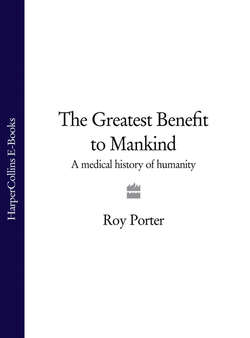Читать книгу The Greatest Benefit to Mankind: A Medical History of Humanity - Roy Porter - Страница 28
INSANITY
ОглавлениеThroughout antiquity, one disorder provoked divergent responses, paving the way for lasting controversy. Madness was, of course, well known within the general culture. Herodotus described the mad destructive King Cambyses of Persia mocking religion – who but a madman would dishonour the gods? The deranged Ajax slaughtered sheep in the belief that they were enemy soldiers, a scene presaging Don Quixote’s tilting at windmills. Violence, grief, blood-lust and cannibalism were commonly taken as signs of insanity.
Graeco-Roman law sought to prevent the mad from destroying life, limb and property, and made provision for guardians for the insane. Insanity was a family responsibility and there were no lunatic asylums. The seriously disturbed were restrained at home, while others were allowed to wander, though, as evil spirits (keres) might fly out of them to possess other people, the crazed were feared and shunned.
Madness found medical explanations. In the Hippocratic tradition the most common labels for such conditions were mania and melancholia, the former characterized by excitement, the latter by depression. Both were marked by delusions, and, like all other maladies, were understood Immorally, usually in terms of choler and black bile. In On the Sacred Disease, which claimed madness as well as epilepsy for medicine, the Hippocratic author stated that ‘those maddened through bile are noisy, evil-doers and restless, always doing something inopportune … But if terrors and fears attack, they are due to a change in the brain.’
Hippocratic medicine thus did not envisage an independent discipline of psychiatry, but it did accept certain psychological elements. In one case, a woman with symptoms of depression and incoherent speech was explained as suffering from ‘grief, while another, ‘after a grief, would ‘fumble, pluck, scratch, pick hairs, weep and then laugh, but … not speak’. Melancholy madness caused by black bile was occasionally seen as the spark of genius, originating the notion of melancholy as a disease of superior wits which achieved its most erudite treatment in Robert Burton’s Anatomy of Melancholy (1621). Plato could similarly represent madness as a transcendental divine fire with the power to inspire, a view influential in the Renaissance and the Romantic movement.
Galen held that mania was a disease of yellow bile or the vital spirits in the heart. A cooling regimen was indicated, for mania was a ‘hot’ disease. Soranus devoted chapters to mania and melancholia, describing symptoms in detail and discussing aetiology. Among the causes of mania were ‘continual sleeplessness, excesses of venery, anger, grief, anxiety, or superstitious fear, a shock or blow, intense straining of the senses and the mind in study, business, or other ambitious pursuits’. Something which could later be interpreted as hysteria – a disorder marked by palpitations, migratory pain, breathing difficulties and the globus hystericus – might be attributed to a wandering uterus. By way of cure for many female psychological disorders, doctors recommended marriage.
The consolidation of Greek and Roman medicine over the course of some seven hundred years laid solid foundations for learned medicine, including the naturalistic notion of disease as part of cosmic order, and the idea of the human body as regulated by a constitution, intelligible to experience and reason. It created the ideal of the union of science, philosophy and practical medicine in the learned physician, who would be the personal attendant of the patient rather than a medicine-man interceding with the gods or a functionary working for the state.
For the next thousand years and more, medical knowledge would change little. This was partly the consequence of the break-up of the Mediterranean civilizations, but also because of the solidity of these foundations. Galen’s enduring reputation was the epitome of these beliefs: he unified theory and practice, discourse and the doctor, but his death brought that tradition to a halt.
* The life of learning could be precarious, as is clear from the fate of even the great Alexandrian library. Part was wrecked in 48 BC during riots sparked by Julius Caesar’s arrival; later Christian leaders encouraged the destruction of the Temple of Muses and other pagan idols. And, so legend has it, in AD 395 the last scholar at the museum, the female mathematician Hypatia, was hauled out of the museum by Christian fanatics and beaten to death. The Muslim conquest of the city in the seventh century resulted in the final destruction of the library.
* Pliny compiled a Natural History, completed AD 77, a compendium of all natural learning. Books 12 – 19 deal with botany and 20–27 with materia medica from botanical sources, followed by five books (28–32) on animal materia medica. His remedies proved of great influence, being quarried by Isidore of Seville and subsequent medieval encyclopaedists.
